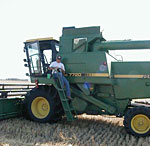A mixed bag for farmers
By Bob Reha, Minnesota Public Radio
August 15, 2001
Farmers are mulling over mixed news. They are use to battling the weather, but this year has been more of a struggle then most. Spring was marked by excessive rain, delaying planting for small grain crops like wheat and barley. Over the past few weeks, extreme heat and humidity has hung over the Midwest. The weather is moderating now, but new national projections predict the price for some crops, notably corn and soybeans may rise as a result of the weather.
NATIONALLY, THE U.S. DEPARTMENT OF AGRICULTURE is predicting the lowest corn harvest since 1997, but it's predicting another record soybean crop. Many Midwestern farmers are still struggling with the effects of a wet spring.
"Certainly some farmers have had to struggle with drown out or else they had struggled with not getting crops planted," says Marsha McMullin, a plant pathologist with North Dakota State University. McMullin says wind storms that swept thru the Red River Valley last week and knocked down, or lodged crops have created the biggest problems.
"I noticed yesterday, for example, a couple combines were in a field south of town near Sabin and they were going really slow on that lodged grain just grinding away, because it takes them a lot longer to pick it up. It makes harvest a little more difficult," McMullin says.
The latest North Dakota crop report says more than a fourth of the barley, oats and spring wheat is in the bin.
Minnesota farmer Kevin Martin farms 1,635 acres near Moorhead. He watched recently as the combine lumbered alongside the truck. A long spout arm swings from the combine and spews grain into the truck. Because of wet weather, Martin's crops were put in late, and he's had mixed results.
"This year hasn't been too bad. The yield, the bushels are up maybe 15 percent above normal, but the quality is down maybe a little bit," he says.
Martin says its a tough time, especially for a young farmer in his late 20s. "I would say if it was not for the government assistance that we do get, I would have been done farming years ago. It's tough times right now; lowest prices in 20-some years."
In recent weeks hot, humid weather was perfect for diseases like scab and rust to develop in small grains. There have been some minor outbreaks in the Red River Valley, but Duane Bergland, an agronomist with North Dakota State University says other areas have not been so lucky. "I've never heard of scab out in the Bowbells, North Dakota area and that's way out in the northwest and theres a lot of scab out there. There's one field (where) the wheat quality tour said was 87 percent scabbed out," according to Bergland.
Bergland says scab and other diseases will reduce yields and hurt the quality of the crop, affecting the farmers' bottom line.
"Wheat just barely pencils out now on the bottom line with 40 to 50 bushels to make any money with wheat and then quality being discounted for quality is very, very important and you can end up with grade three or four grade and probably not get hardly anything other than feed-wheat price under $2 or even under $1 last year," Bergland says.
But the heat wave has helped other crops. Unlike other areas of the Midwest, such as Iowa and Illinois where the heat has damaged corn and soybeans, Bergland says row crops in the valley are doing well.
That's good news for the valley's bean farmers. Weather forecasters are predicting 70-percent of Illinois, Iowa and Minnesota will get up to an inch-and-a-half of rain this week. But it may not be enough to produce a good crop in Illinois and Iowa, the top producers of soybeans last year.
There have been insect problems too. The soybean crop in southwestern Minnesota has been hit by aphids. Speculation over the quality of the soybean crop is driving prices for delivery in November higher. Future prices have risen eight cents in the past six days, they're up 12 percent from a year ago.
For Red River Valley farmers like Kevin Martin, whose bean fields hold the promise of a strong crop, the misfortune of producers elsewhere, may be the key to his future survival.
By Bob Reha, Minnesota Public Radio
August 15, 2001
|
|
RealAudio |
Farmers are mulling over mixed news. They are use to battling the weather, but this year has been more of a struggle then most. Spring was marked by excessive rain, delaying planting for small grain crops like wheat and barley. Over the past few weeks, extreme heat and humidity has hung over the Midwest. The weather is moderating now, but new national projections predict the price for some crops, notably corn and soybeans may rise as a result of the weather.
| |
|
|
|
||
"Certainly some farmers have had to struggle with drown out or else they had struggled with not getting crops planted," says Marsha McMullin, a plant pathologist with North Dakota State University. McMullin says wind storms that swept thru the Red River Valley last week and knocked down, or lodged crops have created the biggest problems.
"I noticed yesterday, for example, a couple combines were in a field south of town near Sabin and they were going really slow on that lodged grain just grinding away, because it takes them a lot longer to pick it up. It makes harvest a little more difficult," McMullin says.
The latest North Dakota crop report says more than a fourth of the barley, oats and spring wheat is in the bin.
Minnesota farmer Kevin Martin farms 1,635 acres near Moorhead. He watched recently as the combine lumbered alongside the truck. A long spout arm swings from the combine and spews grain into the truck. Because of wet weather, Martin's crops were put in late, and he's had mixed results.
"This year hasn't been too bad. The yield, the bushels are up maybe 15 percent above normal, but the quality is down maybe a little bit," he says.
Martin says its a tough time, especially for a young farmer in his late 20s. "I would say if it was not for the government assistance that we do get, I would have been done farming years ago. It's tough times right now; lowest prices in 20-some years."
In recent weeks hot, humid weather was perfect for diseases like scab and rust to develop in small grains. There have been some minor outbreaks in the Red River Valley, but Duane Bergland, an agronomist with North Dakota State University says other areas have not been so lucky. "I've never heard of scab out in the Bowbells, North Dakota area and that's way out in the northwest and theres a lot of scab out there. There's one field (where) the wheat quality tour said was 87 percent scabbed out," according to Bergland.
Bergland says scab and other diseases will reduce yields and hurt the quality of the crop, affecting the farmers' bottom line.
"Wheat just barely pencils out now on the bottom line with 40 to 50 bushels to make any money with wheat and then quality being discounted for quality is very, very important and you can end up with grade three or four grade and probably not get hardly anything other than feed-wheat price under $2 or even under $1 last year," Bergland says.
But the heat wave has helped other crops. Unlike other areas of the Midwest, such as Iowa and Illinois where the heat has damaged corn and soybeans, Bergland says row crops in the valley are doing well.
| |
|
|
|
||
There have been insect problems too. The soybean crop in southwestern Minnesota has been hit by aphids. Speculation over the quality of the soybean crop is driving prices for delivery in November higher. Future prices have risen eight cents in the past six days, they're up 12 percent from a year ago.
For Red River Valley farmers like Kevin Martin, whose bean fields hold the promise of a strong crop, the misfortune of producers elsewhere, may be the key to his future survival.


